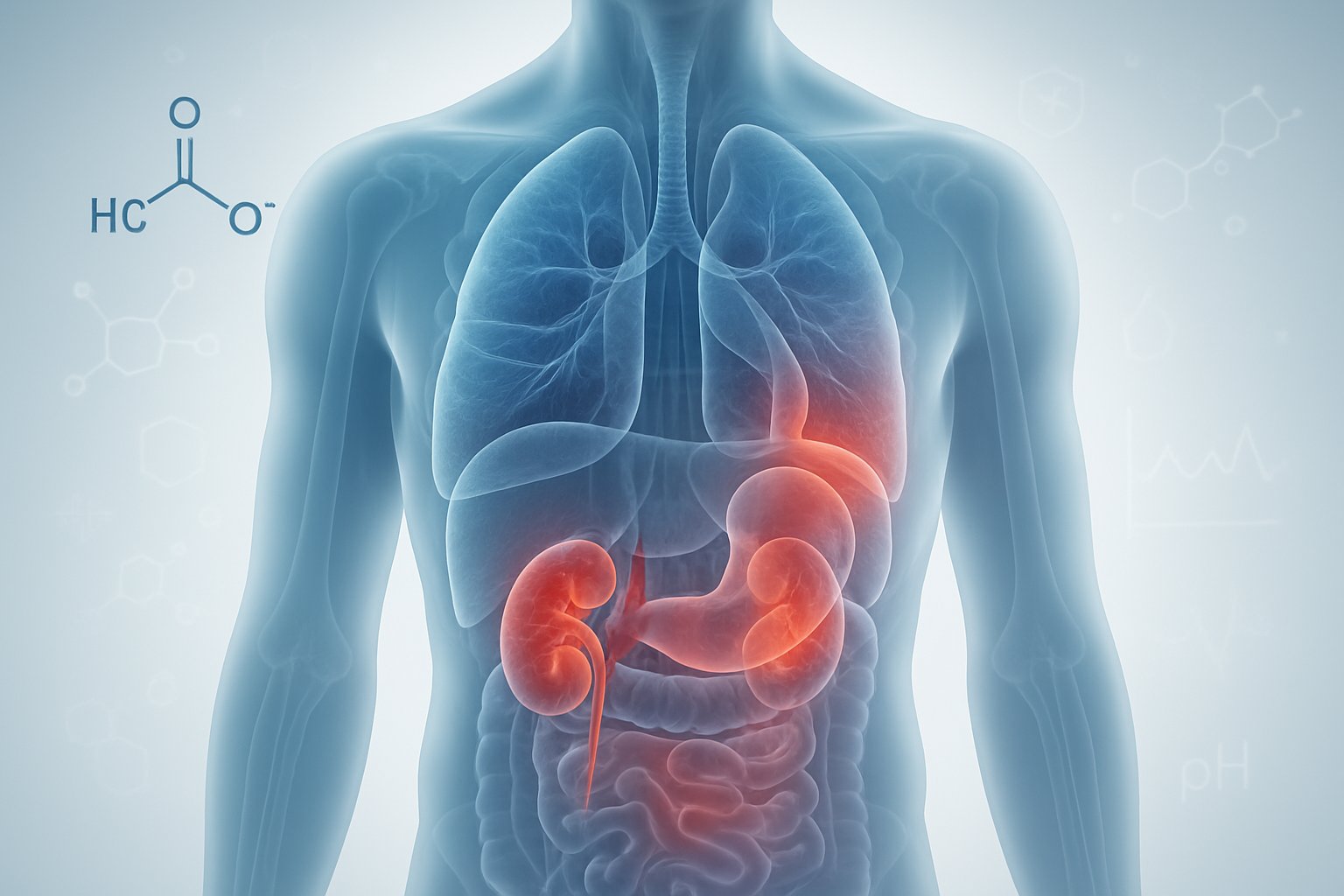Low bicarbonate in the body creates a serious condition called metabolic acidosis, where the blood becomes too acidic for normal body functions. When bicarbonate levels drop, the body loses its ability to neutralize excess acids, leading to symptoms like rapid heartbeat, confusion, fatigue, and potentially life-threatening complications if left untreated.
Bicarbonate acts like a buffer in the bloodstream, helping keep blood from becoming too acidic or too alkaline[1]. This delicate balance is essential for proper organ function, muscle contractions, and cellular processes throughout the body.
Understanding what happens when bicarbonate levels fall can help people recognize warning signs early and seek appropriate medical care. The causes range from kidney disease and diabetes to severe diarrhea, making this condition more common than many realize.
Key Takeaways
- Low bicarbonate causes the blood to become dangerously acidic, disrupting normal body functions
- Common symptoms include rapid heartbeat, confusion, and fatigue that require immediate medical attention
- Treatment focuses on addressing underlying causes while restoring the body’s acid-base balance through medications or IV fluids
Understanding Bicarbonate and Acid-Base Balance

Bicarbonate acts as a buffer that keeps blood pH within a narrow, healthy range. The body maintains this delicate balance through the lungs and kidneys working together to remove excess acids and bases.
The Role of Bicarbonate in the Body
Bicarbonate is a base[2] that serves as the body’s main buffering system. It neutralizes acids that form during normal metabolism.
The body produces bicarbonate ions naturally. These ions travel through the bloodstream to areas where acids need to be neutralized.
Key functions of bicarbonate include:
- Neutralizing excess acids in blood
- Maintaining stable pH levels
- Supporting cellular function
- Helping transport carbon dioxide
When cells break down nutrients for energy, they create acidic waste products. Bicarbonate binds to these acids and makes them less harmful to the body.
How Acid-Base Balance Is Maintained
The lungs and kidneys work together to maintain normal blood pH[3] by removing excess acid. This process happens continuously throughout the day.
The kidneys filter bicarbonate and acids from blood. They can reabsorb bicarbonate when levels are low or remove excess bicarbonate when levels are high.
In the lungs, bicarbonate separates and is breathed out as carbon dioxide[1]. This removes acid from the body through breathing.
The balance system works through:
- Kidney filtration and reabsorption
- Lung ventilation and CO2 removal
- Buffer systems in blood
- Cellular acid production control
When one system fails, the other tries to compensate to maintain proper pH balance.
pH Levels and Health Impacts
Normal blood pH ranges from 7.35 to 7.45[2]. Even small changes outside this range can cause serious health problems.
Low bicarbonate leads to acidic blood conditions. This forces the body’s systems to work harder to maintain proper function.
pH imbalances can cause:
- Rapid breathing patterns
- Heart rhythm changes
- Muscle weakness
- Confusion or fatigue
- Kidney damage over time
The body cannot function properly when pH levels fall below 7.35 or rise above 7.45. Severe imbalances can be life-threatening without treatment.
What Does Low Bicarbonate Mean?

Low bicarbonate levels indicate that the body has too little of this important buffer that keeps blood from becoming too acidic. Healthcare providers typically detect this condition through simple blood tests that measure serum bicarbonate concentrations.
Definition of Low Bicarbonate
Low bicarbonate means there is not enough of this key substance in the blood to maintain proper acid-base balance. Bicarbonate acts like a sponge soaking up excess acid[1] in the body.
Normal bicarbonate levels range from 22 to 28 milliequivalents per liter (mEq/L). When levels drop below 22 mEq/L, doctors consider bicarbonate to be low.
Bicarbonate Level Classifications:
- Normal: 22-28 mEq/L
- Mild deficiency: 18-21 mEq/L
- Moderate deficiency: 12-17 mEq/L
- Severe deficiency: Below 12 mEq/L
When CO2 is too low in blood, serum bicarbonate is also low, meaning the body has too much acid[3]. This creates an imbalance that can affect how organs function.
How Low Bicarbonate Is Detected
Healthcare providers detect low bicarbonate levels through a blood test called a basic metabolic panel or comprehensive metabolic panel. This electrolyte test measures several substances in the blood at once.
The bicarbonate test requires a small blood sample drawn from a vein in the arm. No special preparation is needed before the test.
Common Test Names:
- Serum bicarbonate
- Total CO2
- Carbon dioxide content
- HCO3-
Doctors often order this test when patients show signs of acid-base problems or kidney issues. The test helps identify metabolic acidosis, which occurs when bicarbonate levels become too low.
Results are usually available within a few hours to one day after the blood draw.
Causes of Low Bicarbonate in the Body

Low bicarbonate levels occur when the body produces too much acid, loses too much bicarbonate, or cannot properly regulate acid-base balance. These imbalances stem from medical conditions, kidney problems, lung diseases, and certain medications.
Common Medical Conditions
Several medical conditions directly cause low bicarbonate levels in the blood. Diabetic ketoacidosis occurs when the body breaks down fat for energy[2], creating acidic ketones that lower bicarbonate.
Severe dehydration reduces the body’s ability to maintain proper acid-base balance. When fluid levels drop significantly, bicarbonate concentration can fall as the kidneys struggle to regulate pH levels.
Chronic diarrhea causes direct bicarbonate loss through the intestines. The small intestine normally reabsorbs bicarbonate, but prolonged diarrhea prevents this process.
Renal tubular acidosis (RTA) is a kidney disorder that prevents proper acid removal. The kidneys cannot acidify urine normally, leading to bicarbonate depletion over time.
Other conditions include:
- Addison’s disease
- Lactic acidosis
- Methanol poisoning
- Severe infections
Metabolic Acidosis Explained
Metabolic acidosis develops when acids build up in body fluids[2]. This condition directly lowers bicarbonate levels as the body uses this base to neutralize excess acids.
Two main types exist: high anion gap and normal anion gap metabolic acidosis. High anion gap occurs when the body produces too many acids. Normal anion gap happens when bicarbonate is lost directly.
The body maintains a pH between 7.35 and 7.45 for proper function. When pH drops below this range, bicarbonate levels fall as the body attempts to restore balance.
Ketoacidosis is a common cause in people with diabetes. Without enough insulin, cells burn fat instead of glucose, creating acidic compounds that consume bicarbonate.
Kidneys and Acid-Base Regulation
Kidneys play a crucial role in maintaining normal acid-base balance[3]. They remove excess acids through urine and help regenerate bicarbonate in the blood.
Chronic kidney disease significantly affects bicarbonate levels. As kidney function declines, the organs cannot effectively remove acids or produce adequate bicarbonate.
Advanced kidney disease often leads to persistent low bicarbonate. The damaged kidneys lose their ability to maintain proper pH balance, causing acidosis to develop gradually.
Healthy kidneys filter about 4,000-5,000 milliequivalents of bicarbonate daily. They reabsorb most of this bicarbonate back into the bloodstream while eliminating excess acids.
When kidney function drops below 30%, bicarbonate regulation becomes impaired. This explains why people with severe kidney disease often develop metabolic acidosis.
Medications and Lifestyle Factors
Certain medications can lower bicarbonate levels by affecting kidney function or acid production. Carbonic anhydrase inhibitors like acetazolamide prevent bicarbonate reabsorption in the kidneys.
Salicylate poisoning from aspirin overdose causes both respiratory and metabolic acidosis. The medication interferes with cellular metabolism, leading to acid buildup and bicarbonate consumption.
Metformin, a diabetes medication, can rarely cause lactic acidosis in people with kidney problems. This condition rapidly depletes bicarbonate as the body tries to neutralize excess lactic acid.
Respiratory factors also influence bicarbonate levels. While lung disease like COPD typically causes respiratory acidosis, severe cases can affect overall acid-base balance.
Alcohol consumption can contribute to acidosis through multiple mechanisms, including ketone production and dehydration effects on kidney function.
Signs and Symptoms of Low Bicarbonate

Low bicarbonate levels cause noticeable changes in how the body functions, affecting both physical and mental abilities. These symptoms can range from mild discomfort to serious complications that require immediate medical attention.
Physical and Mental Effects
Low bicarbonate levels directly affect a person’s energy and thinking ability. Metabolic acidosis causes fatigue and confusion[2] as the body struggles to maintain proper pH balance.
Common early symptoms include:
- Muscle weakness throughout the body
- Persistent fatigue that doesn’t improve with rest
- Mental confusion and difficulty concentrating
- General weakness affecting daily activities
The brain is especially sensitive to acid changes in the blood. When bicarbonate drops, people often experience cloudy thinking and memory problems.
Muscle weakness happens because low bicarbonate affects how muscles contract and work. This weakness can make simple tasks like walking or lifting objects more difficult.
Impact on Organs and Systems
Low bicarbonate puts stress on multiple organ systems as they try to fix the acid imbalance. The digestive system responds with nausea and vomiting, which can make the problem worse by removing more bicarbonate from the body.
Organ-specific effects include:
- Digestive: Nausea and vomiting
- Respiratory: Shortness of breath and rapid breathing
- Cardiovascular: Accelerated heartbeat[2]
- Nervous: Dizziness and mental changes
The lungs work harder to remove extra acid by increasing breathing rate. This causes shortness of breath even during rest.
The heart beats faster to help move blood and oxygen around the body more quickly. This increased heart rate can make people feel anxious or uncomfortable.
Recognizing Severe Complications
Severe low bicarbonate can lead to dangerous health complications that need emergency treatment. The body’s systems can start to fail when acid levels become too high.
Warning signs of severe complications:
- Extreme weakness or inability to move
- Severe confusion or loss of consciousness
- Persistent vomiting that won’t stop
- Very rapid or difficult breathing
- Chest pain or irregular heartbeat
These severe symptoms mean the body’s natural ways of fixing acid balance are not working. Low bicarbonate levels are linked to faster progression to kidney failure[3] in people with kidney disease.
When someone has these serious symptoms, their organs may be struggling to function properly. This can lead to permanent damage if not treated quickly by medical professionals.
Diagnosis: How Healthcare Professionals Assess Low Bicarbonate

Healthcare professionals use specific blood tests and detailed medical evaluations to diagnose low bicarbonate levels. They combine laboratory results with patient history to identify the underlying cause.
Laboratory Tests and Interpretation
The primary test for measuring bicarbonate is a basic metabolic panel or comprehensive metabolic panel. These blood tests check bicarbonate levels along with other important electrolytes.
Normal bicarbonate levels range from 22 to 28 milliequivalents per liter. Values below 22 indicate low bicarbonate.
Healthcare professionals often order an electrolyte panel to measure:
- Sodium (normal: 136-145 mEq/L)
- Potassium (normal: 3.5-5.0 mEq/L)
- Chloride (normal: 98-107 mEq/L)
An arterial blood gas test measures blood pH directly. Normal blood pH ranges from 7.35 to 7.45. Low bicarbonate often causes acidic blood pH below 7.35.
Doctors may check the anion gap by calculating the difference between positive and negative charges in blood electrolytes. A high anion gap suggests excess acid production. A normal anion gap indicates bicarbonate loss.
Additional tests include checking glomerular filtration rate to assess kidney function. Poor kidney function can cause bicarbonate loss.
Medical History and Physical Examination
Healthcare professionals ask detailed questions about symptoms and medical conditions. They look for signs of diabetes, kidney disease, or prolonged diarrhea.
Common symptoms include rapid breathing, confusion, fatigue, and nausea. The doctor examines breathing patterns since the lungs try to balance low bicarbonate by removing carbon dioxide.
Medical history questions focus on:
- Diabetes management and blood sugar control
- Kidney problems or family history of kidney disease
- Recent illnesses causing vomiting or diarrhea
- Medications that affect kidney function
Physical examination includes checking vital signs, breathing rate, and mental alertness. Doctors look for signs of dehydration or underlying kidney problems.
The National Kidney Foundation[3] provides guidelines for healthcare professionals to interpret bicarbonate test results and assess kidney function.
Related Conditions and Risk Factors

Low bicarbonate levels often occur alongside other serious health problems and can make existing conditions worse. Electrolyte imbalances, kidney disease progression, and breathing problems all connect to bicarbonate levels in important ways.
Electrolyte Imbalances
When bicarbonate drops, other electrolytes in the body often become unbalanced too. Sodium, potassium, and chloride levels can shift as the body tries to maintain proper pH balance.
Low bicarbonate frequently occurs with high chloride levels. This creates a condition called hyperchloremic acidosis. The kidneys may retain chloride while losing bicarbonate through urine.
Common electrolyte changes include:
- Elevated chloride levels
- Altered sodium balance
- Potassium shifts between cells
- Changes in phosphate levels
These electrolyte imbalances can cause muscle weakness, heart rhythm problems, and confusion. The body’s attempt to correct acid-base balance often disrupts normal electrolyte function.
Severe electrolyte imbalance can lead to dangerous complications. Heart problems and muscle paralysis may occur when multiple electrolytes become severely disrupted.
Chronic Kidney Disease and Progression
Low serum bicarbonate increases the risk of reaching kidney failure[3] faster than normal levels. Damaged kidneys cannot remove acids properly or make enough bicarbonate.
Chronic kidney disease creates a cycle where kidney dysfunction leads to low bicarbonate. The acidic environment then damages kidneys further and speeds up disease progression.
Key factors in kidney disease progression:
- Reduced acid removal capacity
- Decreased bicarbonate production
- Protein breakdown from acidic conditions
- Bone mineral loss
Studies show patients with chronic kidney disease and low bicarbonate reach kidney failure sooner. The acidic blood environment puts extra stress on already damaged kidney tissue.
Treatment with bicarbonate supplements may slow kidney disease progression. However, the underlying kidney damage must also be addressed to prevent further decline.
Respiratory Conditions and Acid-Base Regulation
The lungs play a crucial role in maintaining acid-base balance by controlling carbon dioxide levels. When bicarbonate is low, the lungs try to compensate by breathing faster and deeper.
Chronic obstructive pulmonary disease and other lung diseases can prevent proper compensation. Damaged lungs cannot remove enough carbon dioxide, making acidosis worse.
Respiratory compensation includes:
- Increased breathing rate
- Deeper breathing patterns
- Lower carbon dioxide levels in blood
- Reduced carbonic acid formation
Some patients develop mixed acid-base disorders. Both respiratory and metabolic problems contribute to abnormal pH and bicarbonate levels.
Lung disease patients may experience metabolic alkalosis instead of acidosis. Certain medications and treatments can cause bicarbonate levels to become too high rather than too low.
Treatment and Management of Low Bicarbonate

Doctors typically treat low bicarbonate by addressing the underlying cause and replacing lost bicarbonate through medical interventions. Treatment plans often combine medications, dietary changes, and regular monitoring to restore proper acid-base balance in the body.
Medical Treatment Options
Sodium bicarbonate supplements[2] are the most common treatment for low bicarbonate levels. Doctors prescribe these in tablet or powder form to help restore normal blood pH levels.
IV fluid therapy may be necessary for severe cases. Hospitals use intravenous bicarbonate solutions when patients cannot take oral medications or need rapid correction.
The dosage depends on several factors:
- Current bicarbonate level
- Body weight
- Kidney function
- Underlying medical conditions
Doctors may adjust other medications that affect bicarbonate levels. They might reduce diuretics or change blood pressure medications if these drugs contribute to bicarbonate loss.
Insulin therapy becomes important for diabetic patients. Proper blood sugar control helps prevent further acid buildup in the body.
Dietary and Lifestyle Modifications
Patients should increase their intake of fruits and vegetables to support alkaline balance. These foods help the body maintain proper pH levels naturally.
Key dietary changes include:
- Eating more leafy greens and citrus fruits
- Reducing processed foods and excess protein
- Limiting sodium intake unless prescribed otherwise
Proper hydration plays a crucial role in treatment. Drinking adequate water helps kidneys function better and process acids more effectively.
Patients should avoid excessive alcohol consumption. Alcohol can worsen acid-base imbalances and interfere with kidney function.
Exercise modifications may be necessary. Intense workouts can temporarily increase acid production, so patients should follow their doctor’s activity guidelines.
Monitoring and Ongoing Care
Regular blood tests track bicarbonate levels and overall kidney function. Most patients need testing every 3-6 months or more frequently during treatment adjustments.
Doctors monitor the anion gap to determine if treatment is working. This measurement helps identify whether the underlying cause is being addressed effectively.
Patients learn to recognize warning signs of worsening symptoms:
- Increased fatigue
- Rapid breathing
- Confusion
- Nausea
Home monitoring may include tracking daily weight and fluid intake. Some patients use pH test strips to monitor urine acidity levels.
Healthcare teams coordinate care between specialists. Kidney doctors, primary care physicians, and dietitians work together to optimize treatment plans.
Medication adjustments happen based on test results and symptoms. Doctors fine-tune bicarbonate supplement doses to maintain stable levels without overcorrection.
Frequently Asked Questions

Low bicarbonate levels create specific symptoms and health risks that people need to understand. Treatment options and dietary changes can help manage this condition effectively.
What are the common symptoms of low bicarbonate levels in the body?
People with low bicarbonate levels often experience rapid breathing as their body tries to remove excess acid. They may feel confused or tired more than usual.
Metabolic acidosis symptoms include an accelerated heartbeat[2] and fatigue. Some individuals notice muscle weakness or nausea.
Severe cases can cause drowsiness or difficulty thinking clearly. The person’s breath may smell fruity, especially if diabetes is involved.
How does a decrease in bicarbonate affect the pH balance within the body?
Bicarbonate acts as a buffer that keeps blood from becoming too acidic. When bicarbonate levels drop, the blood becomes more acidic than normal.
The body needs a normal pH range from 7.35 to 7.45[2] to work properly. Low bicarbonate pushes this balance toward the acidic side.
The lungs and kidneys work harder to restore normal pH levels. This extra work can stress these organs over time.
What are the potential risks or complications associated with chronic low bicarbonate levels?
Long-term low bicarbonate can damage the kidneys and make existing kidney disease worse. Bone health may suffer as the body uses calcium to neutralize excess acid.
Heart problems can develop from the constant strain of managing acid levels. The cardiovascular system works harder to pump blood effectively.
Muscle wasting may occur as proteins break down to help buffer acid. This can lead to weakness and reduced physical function.
Which underlying conditions can lead to a reduction in bicarbonate levels in the bloodstream?
Diabetes is a common cause when blood sugar stays too high for too long. The body makes acids called ketones that use up bicarbonate.
Kidney disease or kidney failure[2] prevents proper acid removal from the blood. Severe diarrhea causes direct bicarbonate loss.
Certain medications like aspirin or methanol poisoning can increase acid production. Starvation forces the body to break down fat, creating excess acids.
What dietary changes might be recommended to manage and improve low bicarbonate levels?
Eating more fruits and vegetables provides natural alkaline compounds that help balance acid levels. Foods like bananas, oranges, and leafy greens are particularly helpful.
Reducing protein intake may decrease acid production in some cases. Limiting processed foods and added sugars can prevent additional acid formation.
Staying well-hydrated helps the kidneys remove acids more effectively. Some doctors recommend adding small amounts of baking soda to water under medical supervision.
What treatment options are available for addressing low bicarbonate levels?
Doctors may prescribe sodium bicarbonate pills or IV fluids to directly replace missing bicarbonate. The dosage depends on how severe the deficiency is.
Treating the underlying cause is essential for long-term success. This might include better diabetes control or kidney disease management.
Treatment may include IV fluids and insulin[2] for diabetes-related cases. Regular blood tests monitor progress and adjust treatment plans.
References
- Bicarbonate. https://www.pathologytestsexplained.org.au/ptests.php?q=Bicarbonate Accessed October 25, 2025
- Metabolic Acidosis: Causes, Symptoms, Diagnosis & Treatment. https://my.clevelandclinic.org/health/diseases/24492-metabolic-acidosis Accessed October 25, 2025
- Serum Bicarbonate. https://www.kidney.org/kidney-failure-risk-factor-serum-bicarbonate Accessed October 25, 2025
